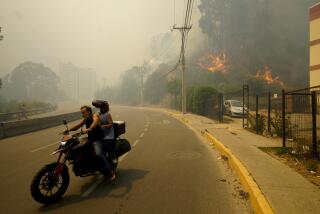From Andes to the Caribbean, Tropical Areas Are Gripped by Devastating Drought
- Share via
SAN JUAN, Puerto Rico — Relentless sunshine and months without rain have brought a devastating drought to the tropical savannas, jungles and foothills that stretch from South America’s Andes Mountains to Caribbean tourist havens.
Meteorologists say the region’s rainfall has been a third to a half the normal level--a longer, harsher version of the winter dry season usually broken by April rains welling north from the Amazon River basin.
This spring the skies are a clear, burning blue.
‘No Sign of Rain’
“It has been particularly damaging because there has been no sign of rain, which is worrying,” said Guillermo Colmenares Finol, a spokesman for Venezuela’s Department of Environment and Natural Resources.
“This far into the year we would have already had rain in the south and west of the country. Generally the rains fall in April, but this has not been the case,” he said.
Meteorologists have no explanation for the drought.
The stricken area runs from Venezuela and Colombia, where reservoirs supplying Bogota, the capital, are only one-third full, through Suriname and Guyana on the coast to Barbados, Trinidad and other Caribbean islands.
Water rationing is in effect in much of the region, parts of which also had far below average rainfall in 1987.
80-Degree Average
Guyana and Suriname, low-lying countries with average temperatures of about 80 degrees, have been especially hard hit.
Guyana’s projected rice production from the year’s first harvest has fallen from 80,000 tons to 55,000 tons--a 31% drop. The socialist government is ordering producers to sell part of their crop to the state rice company.
Water levels have fallen so low in irrigation canals that sea water is entering channels and fouling rice plots. Annual rainfall in Guyana, a former British colony of about 800,000 people, has been just below half the normal 90 inches since 1986.
Suriname’s coastal plain has been burned dusty brown, and cattle and banana plantations are reported to be suffering severely. Rice planting is halted, and the new civilian government is trying to import new pumps for water wells.
A measuring station monitored by the World Meteorological Organization at Paramaribo shows 7.5 inches of rain from January to mid-April--down from an average of 22.5 inches for the period.
Savannas Devastated
Brush fires have devastated Trinidad’s tinder-dry savannas and mountains and damaged cane fields in Barbados, where less than 2 inches of rain have fallen since the start of March.
A brush fire April 26 swept over a Trinidad army base and detonated high explosives stored in a bunker, killing six people. A similar blaze destroyed a Paramaribo clothing factory the same week.
Mervyn Sankeralli, technical director of Trinidad’s Water and Sewerage Authority, said the agency was having to tap river water and wells to supply consumers because of falling levels in reservoirs.
Complete estimates of economic damage from the regional drought were not available.
However, farmers in Colombia’s southern province of Tolima have suffered losses of about $420,000 from the drought, which has delayed the planting of some crops, agricultural spokesmen said.
One-Tenth of Normal
April rainfall in Bogota, Colombia’s Andean capital, is about half an inch--a tenth the norm. However, coffee crops in north-central Colombia have enjoyed more-than-normal rainfall and have not been affected by the drought.
Areas bordering the drought-stricken region have seen normal rainfall, and the Paraguai River in central Brazil flooded in mid-April to 20 feet above normal--equal to its highest-ever flood in 1905.
The islands of the northern Caribbean have had seasonal rainfall, with Puerto Rico in mid-April reporting an island-wide average of 10.1 inches, about half an inch above normal, according to the U.S. National Weather Service.
More to Read
Sign up for Essential California
The most important California stories and recommendations in your inbox every morning.
You may occasionally receive promotional content from the Los Angeles Times.













